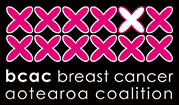Initial trial results on the cost and effectiveness of MRI breast cancer screening compared to mammography, in women with a familial risk, have been presented at the San Antonio Breast Cancer Symposium. The FaMRIsc study is the first randomised trial that has made this comparison.
The researchers, Madeleine MA Tilanus-Linthorst et al, conclude that MRI-screening advances the detection of breast cancer greatly, but that additional investigations are required. They find that MRI-screening may be cost-effective in groups with sufficient tumor incidence, like women with familial risk.
BCAC Secretary Fay Sowerby says this is promising research that can help guide future decision making to improve breast cancer detection and treatment.
“New Zealand needs to remain up to date with developments in this area so we can make the best decisions for women with a high risk of breast cancer.”
Background
The findings are reported by the researchers in their Symposium paper: Costs and effects in the first randomized trial comparing MRI breast cancer screening with mammography in women with a familial risk: FaMRIsc.
The researchers note as background in their paper that: “The large favorable stage shift, that MRI screening causes as compared with mammography has been published recently in Lancet Oncology as well as the disadvantage of more false-positive results with MRI.”
The FaMRIsc Trial
In 12 Dutch hospitals, 1355 women aged 30-55 years with a cumulative lifetime risk (CLTR) of ≥20% without a BRCA1/2 mutation were randomised into two groups.
From January 2011 until December 2017:
- women in the MRI-group received yearly MRI-screening, clinical breast examination (CBE), and mammography every other year; and
- women in the Mx-group received yearly mammography and CBE.
Results
- In their paper, the researchers present cost per group as well as per detected cancer in both groups, also by age group and breast density. Cost per life year gained can be presented in December.
- After on average 4.3 screening rounds per woman, in the MRI-group (N=674) compared to the Mx-group (N=680) more breast cancers were detected (40 versus 15, p<0.002), invasive cancers were smaller (median size 9 versus 17 mm, p=0.01) and less often node positive (17% versus 63%, p=0.023) (Table).
- This resulted in lower cost for detection and treatment per tumor in the MRI-group compared to the Mx-group and lower mean treatment costs (MRI-group: €6,736; Mx-group: €10,128).
- In incident rounds fewer large or node positive cancers were detected with MRI, reducing the cost for adjuvant therapy, but there remained more false positive results and biopsies with MRI, increasing the cost for additional investigations.
- The total cost of MRI screening was nearly twice as high as for mammography-screening.
- Per detected cancer MRI screening was cheaper than mammography, especially above 50 yrs. and at density A-C.
Funding
The study was supported by funds of: the Dutch Government ZonMw grant no. 200320002, The Dutch Cancer Society (DDHK 2009-4491), A Sisters Hope, Pink Ribbon, Stichting Coolsingel, J&T Rijke Stichting.
For more information:
Tilanus-Linthorst MMA. et al. Costs and effects in the first randomized trial comparing MRI breast cancer screening with mammography in women with a familial risk: FaMRIsc. Paper presented at San Antonio Breast Cancer Symposium; 2019 Oct 10-14; San Antonio, USA.
MRI vs mammography screening for high-risk women: an RCT - the influence of density and effectiveness. A. Geuzinge1, S. Saadatmand1, E. J. J. Rutgers2, R. M. Mann3, D. de Roy van Zuidewijn4, H. Zonderland2, R. Tollenaar5, M. Lobbes6, M. Ausems7, M. van 't Riet8, M. Hooning1, I. Mares-Engelberts1, E. Luiten9, E. Heijnsdijk1, C. Verhoef1, N. Karssemeijer3, J. Oosterwijk10, I.-M. Obdeijn1, H. de Koning1, M. Tilanus-Linthorst1; 1Rotterdam/NL 2Amsterdam/NL 3Nijmegen/NL 4Leeuwarden/NL 5Leiden/NL 6Maastricht/NL 7Utrecht/NL 8Delft/NL 9Breda/NL 10Groningen/NL



